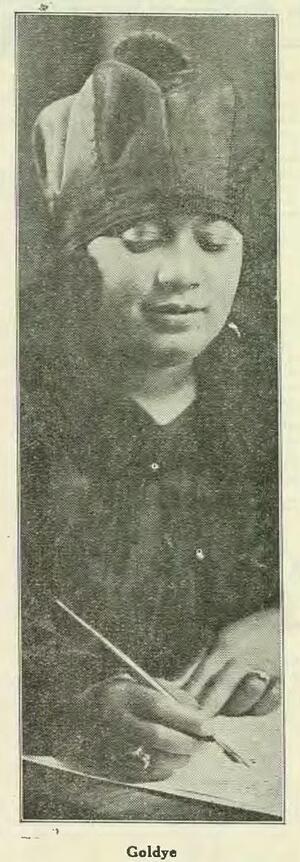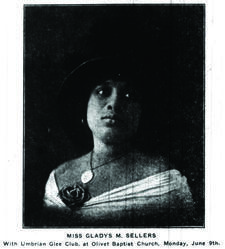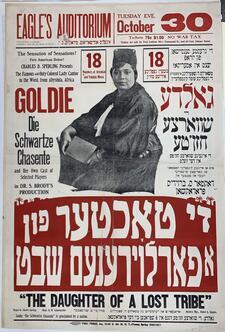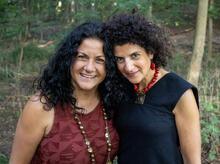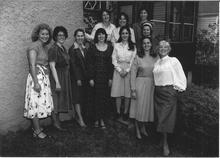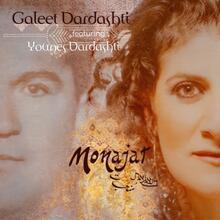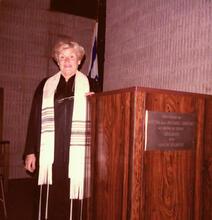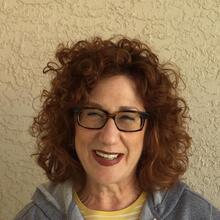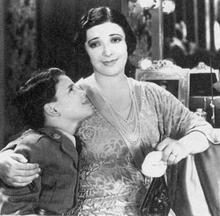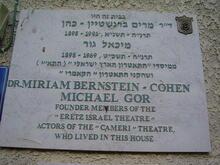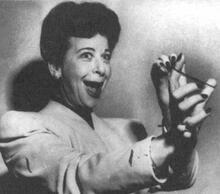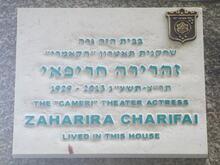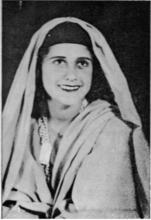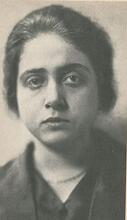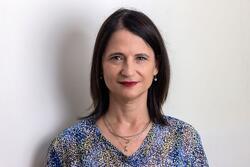Madame Goldye Steiner, aka Gladys Mae Sellers
Madame Goldye Steiner was the pseudonym of Gladys Mae Sellers, trailblazing early 20th century vocalist. She performed with early Jazz innovators as well as in the Yiddish theater and on Broadway, and she was the first to sing the famous song "Frankie and Johnny" on a major American stage. As "Goldye di Shvartze Khaznte," or “Goldye the Colored Woman Cantor,” she was the first known African-American woman singer of khazones, or Ashkenazi Jewish liturgical music, and she was the only known African-American woman in the khaznte artistic movement, in which non-synagogue audiences experienced khazones, sung by women in concert halls, on the radio, and on gramophone recordings.
Introduction
Madame Goldye Steiner was the pseudonym of Gladys Mae Sellers, the pioneering African-American woman vocalist who enjoyed two successful careers—one as a soloist based in Milwaukee’s early African American community, performing operatic and African-American musical pieces, and one as a Harlem-based Broadway performer, Yiddish theater favorite, and part of the khaznte artistic movement, in which women sang khazones (Jews of European origin and their descendants, including most of North and South American Jewry.Ashkenazi Jewish liturgical music) in concerts, on radio, and on gramophone recordings. Over both careers, she sang to high acclaim, across multiple cities, and in multiple languages.
Early Career
Though she routinely misrepresented her age beginning in her thirties, Sellers was likely born in 1889 in Illinois and she grew up in Milwaukee, Wisconsin, with her brother, Theodore, and their mother, Emma Sellers Barnett. The family lived first as boarders and then as renters in multiple apartments, eventually settling on Chestnut Street (now West Juneau Avenue). Young Gladys attended Milwaukee Public Schools through the age of sixteen; four years later, when she was twenty, her mother stated to a census-taker that Sellers had steady work as an actress in the theater.
Milwaukee Career
By the 1910s, Sellers was a known vocalist in the African American community of Milwaukee, which at that time numbered roughly 1000 people. Around 1913, she began performing with regional stars The Weaver Brothers, appearing with them at the Fountain Inn and elsewhere. She also performed with an early jazz innovator, the well-known John Wickliffe and his Ginger Orchestra, in Minneapolis and in Chicago.
Sellers gave solos at important community events, such as a Wisconsin convention for African American race unity in Oshkosh (1916), World War I sendoffs for colored soldiers in Milwaukee (1917, 1918, 1919), and Wisconsin Day at the national Half Century Anniversary of Negro Freedom event in Chicago (1918), which marked the 50-year anniversary of the Emancipation Proclamation. She was a regular leader of music programs and recitals in the community, often at St. Mark AME Church, which was the center of Milwaukee’s African-American community life.
Sellers began using “Mademoiselle,” the honorific typically used for young opera singers, after completing a course in Chicago with African-American music educator and activist Madame Emma Azalia Hackley. In 1917, Sellers was offered an extended engagement through the national Consolidated Vaudeville Exchange (an early African-American theater circuit that was a precursor to the Theatre Owners Booking Association [TOBA] and later "chitlin' circuit"), but she was unable to accept due to ill health. In 1919, after hearing Sellers sing at the behest of her fellow Milwaukee Pabst Theater ushers, the great African American musical innovator and originator Will Marion Cook invited her to tour with him.
In 1922, Sellers performed with Wickliffe on a WAAK radio station broadcast from Milwaukee’s Gimbels department store. This radio appearance makes Sellers among the very first vocalists in history to perform live on commercial radio.
Khaznte Debut and New York Career
In 1924, Sellers debuted as "Goldye di Shvartze Khaznte," translated as "Goldye, the Colored Woman Cantor." (When used as a noun, the term "shvartze," Yiddish for “black,” has been consistently used and understood as a racial epithet against African Americans since the early twentieth century. However, when used as an adjective in this time period, the term was much less likely to possess the connotation of a racial slur. The term can be correctly interpreted here as the equivalent of “Colored.”)
Using the very Ashkenazi Jewish pseudonym Goldye Steiner, she sang khazones and other Jewish songs under this name for the next fifteen years. It is unknown whether Steiner herself was Ashkenazi and unclear if she identified as Jewish, and whether she learned Yiddish and khazones in her family and community or from phonograph recordings remains a mystery. What is known, however, is that Steiner was very well received by Yiddish-speaking audiences and the Yiddish press, where she received consistently fond reviews.
Steiner’s 1924 khaznte debut took place in Indiana at a benefit for the South Bend Hebrew Institute, as that community was recovering from a weeklong violent event in which Notre Dame students had rioted against the Ku Klux Klan. Significantly, this appearance is only the second known public stage performance of a woman singing khazones, following the 1920 debut of khaznte Madame Sophie Kurtzer.
In 1926, Steiner appeared in Jewish American Broadway innovator David Belasco’s Lulu Belle, a controversial production both in its time as well as today, due to its use of blackface and promotion of harmful racial stereotypes. During Lulu Belle rehearsals, Steiner became a member of the racially integrated Actor's Equity Association labor union. In 1928, she appeared in e.e. cummings' avant-garde off-Broadway play, him. In 1929, Steiner starred in the title role of the Yiddish play Tachter fun a forloyeren shevet (Daughter from a Lost Tribe), in which she played a fictionalized version of herself.
Later Career
From 1933 to 1938, Steiner appeared as a regular on the “Cathedral of the Underworld” radio program, a fundraiser for the mission run by former petty criminal and “down and outer” Tom Noonan, a.k.a. "The Bishop of Chinatown." Steiner was so beloved by Jewish audiences that this Christian radio program was regularly included in Yiddish radio program directories. In 1938, she appeared as “Goldie Mae Steiner, only Negress cantor in the world,” in a star-studded, marathon benefit gala for the Brooklyn Urban League, whose lineup included Louis Armstrong and Duke Ellington. She appeared in two 1939 Alexander Olshanetsky musicals that starred Izaak Feld: credited as Gladys Mae Sellers in Der poylisher rebe (The Polish Rabbi), and as Goldye the Colored Woman Cantor in Der rebbetzins gigolo (The Rabbi’s Wife’s Boyfriend). Her last known performance was as Goldie Steiner, in July of 1941 at the Elks Crystal Hall in Brooklyn, where she performed “a program of Hebrew chants from the synagogues" assisted by Sheoh Khall’s Electric Choir of Boston.
“Frankie and Johnny” Performance
In 1928, Steiner’s appearance in e.e. cummings' him marked the first performance of the song “Frankie and Johnnie” on a major American stage. Steiner sang the song, accompanied by a chorus of 45 singers and dancing a “cake walk” dance with famed choreographer and father of Negro dance Hemsley Winfield. The performance was immortalized in an etching by famous American artist John Sloan, and the song went on to become a significant entry in the repertoire of American popular culture.
Tachter fun a forloyeren shevet (Daughter from a Lost Tribe)
1929 saw several performances of the Yiddish theater production Tachter fun a forloyeren shevet (Daughter from a Lost Tribe), which starred Steiner as herself in the title role, singing in six languages. The musical was a fictionalized account of her life: born into a lost tribe of African Jews called “Sheba of Gza,” she was one of the most beautiful women in Africa; one day, she was discovered by a chieftain who sent her to Milan to study opera and then on to perform in America. The story was already well-used by the time it became a full-blown musical, as it had been employed in newspaper announcements for Steiner’s performances, often accompanied by the claim that a given performance was her first-ever appearance in America.
Marriages and Death
In 1915, Sellers married Albert Smack, “the famous falsetto tenor,” probably while they were both on the road performing with either the Weaver Brothers or John Wickliffe and his Ginger Orchestra. Around 1923, when Sellers relocated to Harlem, New York, she likely did so with Richard Armstead—whom she had probably met when they were both living in the same Milwaukee apartment building in the early 1920s. They married in 1941.
In Harlem, Steiner lived at the same Morningside Drive address for roughly twenty years. In 1940, Steiner’s mother died there, after she relocated to Harlem and lived with her daughter for several years. Steiner and Richard Armstead returned to Milwaukee soon after, attempting unsuccessfully to build a stable family life with Armstead’s daughter, Vivian, who had been born in Milwaukee in 1941 to a white mother and promptly placed in foster care. Armstead died in 1953, and we know little about Steiner and Vivian’s relationship following Armstead’s death.
Steiner died on December 1, 1960, of complications from high blood pressure. She was buried as Gladys M. Armstead in an unmarked grave at Mt. Olivet Cemetery in Milwaukee.
In 2023, a research effort stewarded by Edot Midwest Regional Jewish Diversity and Racial Justice Collaborative located Steiner’s unmarked grave, and the organization partnered with the Wisconsin Black Historical Society and Museum to raise funds and purchase grave markers for Steiner and Armstead. The markers were dedicated in August 2024. Although Steiner’s actual birth year was 1889, the grave marker lists a birth year of 1895 as a nod to her age fabrications.
Name and Pseudonym Variations
Gladys Sellers used the Goldye Steiner pseudonym as a stage name and in official documents, including the census, phone directory, and her Actor’s Equity union application. There are over 25 known variations and combinations, as well as media and census misspellings, of Sellers/Steiner’s name, including Goldye Mae Sellers, Goldie Schwartze Chasente, and Millie Goldye Steiner (probably changed in error by a journalist from “Mlle,” or Mademoiselle).
2020s Revival
Musician and author Henry Sapoznik included Steiner in a 2020 viral blog post on early African-American singers of khazones. Ethnomusicologist Jeremiah Lockwood has included treatment of Steiner in his 2020s scholarly work on the khazntes movement. In 2022, educator Shahanna McKinney-Baldon began performing as Steiner in conjunction with fundraising efforts for Steiner’s grave marker. In 2024, McKinney-Baldon established a new organization, Gladys ARTS, to preserve and promote the legacy of Gladys Sellers/Goldye Steiner. Gladys ARTS’ mission is to illuminate and celebrate Sellers’ remarkable achievements and provide a platform for contemporary African-American cantors and other singers of khazones.
Conclusion
Madame Goldye Steiner/Gladys Mae Sellers was a trailblazing vocalist in the African-American and Jewish-American musical histories of the early twentieth century. Her life and career stand as testaments to the powers of music, creativity, and cultural exchange, and also as a vivid reflection of the complex social and cultural landscapes of early twentieth-century America. Her groundbreaking work as both an African-American vocalist and a khaznte places her at the intersection of pivotal historical and artistic moments and movements, including jazz, Broadway, Yiddish theater, and the Harlem Renaissance, as well as the development of the modern African-American, Jewish-American, and Black Jewish experiences.
Brown, Arianne. The Hazntes. Master's thesis, H.L. Miller Cantorial School, Jewish Theological Seminary, 2005. https://independent.academia.edu/ArianneBrown.
Sapoznik, Henry. "Goldye, Di Shvartze Khaznte/The Black Woman Cantor." Henry Sapoznik, August 25, 2020. https://www.henrysapoznik.com/post/goldye-di-shvartze-khaznte-the-black-woman-cantor.
Silver, Maayan. "Milwaukeeans Gather to Celebrate Goldye Steiner: First Black Woman Cantor." WUWM 89.7 FM, February 9, 2023. Updated January 14, 2025. https://www.wuwm.com/2023-02-09/milwaukees-goldye-steiner-first-black-woman-cantor-in-the-golden-age-of-jewish-prayer-music.

